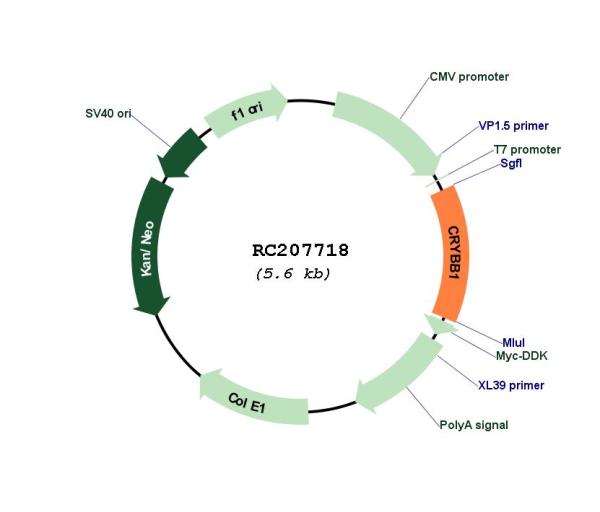beta B1 Crystallin (CRYBB1) (NM_001887) Human Tagged ORF Clone
CAT#: RC207718
CRYBB1 (Myc-DDK-tagged)-Human crystallin, beta B1 (CRYBB1)
ORF Plasmid: tGFP
Lentiviral Particles: DDK w/ Puro mGFP w/ Puro
AAV Particle: DDK
"NM_001887" in other vectors (4)
USD 198.00
Specifications
| Product Data | |
| Type | Human Tagged ORF Clone |
| Tag | Myc-DDK |
| Symbol | beta B1 Crystallin |
| Synonyms | CATCN3; CTRCT17 |
| Vector | pCMV6-Entry |
| E. coli Selection | Kanamycin (25 ug/mL) |
| Mammalian Cell Selection | Neomycin |
| Sequence Data |
>RC207718 ORF sequence
Red=Cloning site Blue=ORF Green=Tags(s) TTTTGTAATACGACTCACTATAGGGCGGCCGGGAATTCGTCGACTGGATCCGGTACCGAGGAGATCTGCC GCCGCGATCGCC ATGTCTCAGGCTGCAAAGGCCTCGGCCTCGGCCACAGTGGCGGTGAACCCAGGGCCTGACACCAAGGGGA AGGGGGCCCCACCTGCAGGAACATCCCCTAGTCCCGGCACTACCCTGGCCCCAACAACCGTGCCTATTAC CAGCGCCAAGGCGGCGGAACTGCCTCCTGGGAACTACAGGCTGGTGGTCTTCGAACTGGAAAACTTCCAG GGCCGTCGAGCAGAATTCTCGGGGGAGTGCTCAAATCTGGCAGACCGTGGCTTCGACCGTGTGCGCAGCA TCATTGTCTCCGCGGGACCCTGGGTCGCCTTTGAGCAGTCCAACTTCCGCGGGGAGATGTTCATCCTGGA GAAGGGCGAGTACCCTCGCTGGAACACATGGTCGAGCAGCTACCGCAGTGATCGGCTCATGTCCTTCCGG CCCATCAAAATGGATGCCCAGGAGCACAAAATCTCCCTGTTTGAAGGGGCCAACTTCAAGGGCAACACCA TAGAGATCCAGGGGGACGACGCACCCAGTCTCTGGGTCTACGGCTTCAGTGACCGCGTGGGCAGCGTGAA GGTCTCCAGTGGAACATGGGTTGGCTATCAGTATCCTGGCTACCGCGGGTACCAGTACCTCCTAGAGCCT GGTGACTTCCGGCACTGGAATGAGTGGGGAGCCTTCCAGCCACAGATGCAGTCCCTGCGTCGCCTGCGTG ACAAGCAGTGGCACCTCGAGGGGTCCTTCCCTGTCCTGGCCACAGAGCCCCCCAAG ACGCGTACGCGGCCGCTCGAGCAGAAACTCATCTCAGAAGAGGATCTGGCAGCAAATGATATCCTGGATT ACAAGGATGACGACGATAAGGTTTAA >RC207718 protein sequence
Red=Cloning site Green=Tags(s) MSQAAKASASATVAVNPGPDTKGKGAPPAGTSPSPGTTLAPTTVPITSAKAAELPPGNYRLVVFELENFQ GRRAEFSGECSNLADRGFDRVRSIIVSAGPWVAFEQSNFRGEMFILEKGEYPRWNTWSSSYRSDRLMSFR PIKMDAQEHKISLFEGANFKGNTIEIQGDDAPSLWVYGFSDRVGSVKVSSGTWVGYQYPGYRGYQYLLEP GDFRHWNEWGAFQPQMQSLRRLRDKQWHLEGSFPVLATEPPK TRTRPLEQKLISEEDLAANDILDYKDDDDKV |
| Chromatograms |
CHROMATOGRAMS
 Sequencher program is needed, download here. |
| Restriction Sites |
SgfI-MluI
Cloning Scheme for this gene
Plasmid Map

|
| ACCN | NM_001887 |
| ORF Size | 756 bp |
| OTI Disclaimer | The molecular sequence of this clone aligns with the gene accession number as a point of reference only. However, individual transcript sequences of the same gene can differ through naturally occurring variations (e.g. polymorphisms), each with its own valid existence. This clone is substantially in agreement with the reference, but a complete review of all prevailing variants is recommended prior to use. More info |
| OTI Annotation | This clone was engineered to express the complete ORF with an expression tag. Expression varies depending on the nature of the gene. |
| Product Components | The ORF clone is ion-exchange column purified and shipped in a 2D barcoded Matrix tube containing 10ug of transfection-ready, dried plasmid DNA (reconstitute with 100 ul of water). |
| Reconstitution | 1. Centrifuge at 5,000xg for 5min. 2. Carefully open the tube and add 100ul of sterile water to dissolve the DNA. 3. Close the tube and incubate for 10 minutes at room temperature. 4. Briefly vortex the tube and then do a quick spin (less than 5000xg) to concentrate the liquid at the bottom. 5. Store the suspended plasmid at -20°C. The DNA is stable for at least one year from date of shipping when stored at -20°C. |
| Reference Data | |
| RefSeq | NM_001887.4 |
| RefSeq Size | 921 bp |
| RefSeq ORF | 759 bp |
| Locus ID | 1414 |
| UniProt ID | P53674 |
| Cytogenetics | 22q12.1 |
| MW | 28 kDa |
| Gene Summary | Crystallins are separated into two classes: taxon-specific, or enzyme, and ubiquitous. The latter class constitutes the major proteins of vertebrate eye lens and maintains the transparency and refractive index of the lens. Since lens central fiber cells lose their nuclei during development, these crystallins are made and then retained throughout life, making them extremely stable proteins. Mammalian lens crystallins are divided into alpha, beta, and gamma families; beta and gamma crystallins are also considered as a superfamily. Alpha and beta families are further divided into acidic and basic groups. Seven protein regions exist in crystallins: four homologous motifs, a connecting peptide, and N- and C-terminal extensions. Beta-crystallins, the most heterogeneous, differ by the presence of the C-terminal extension (present in the basic group, none in the acidic group). Beta-crystallins form aggregates of different sizes and are able to self-associate to form dimers or to form heterodimers with other beta-crystallins. This gene, a beta basic group member, undergoes extensive cleavage at its N-terminal extension during lens maturation. It is also a member of a gene cluster with beta-A4, beta-B2, and beta-B3. [provided by RefSeq, Jul 2008] |
Documents
| Product Manuals |
| FAQs |
| SDS |
Resources
Other Versions
| SKU | Description | Size | Price |
|---|---|---|---|
| RC207718L3 | Lenti ORF clone of Human crystallin, beta B1 (CRYBB1), Myc-DDK-tagged |
USD 600.00 |
|
| RC207718L4 | Lenti ORF clone of Human crystallin, beta B1 (CRYBB1), mGFP tagged |
USD 600.00 |
|
| RG207718 | CRYBB1 (tGFP-tagged) - Human crystallin, beta B1 (CRYBB1) |
USD 500.00 |
|
| SC303090 | CRYBB1 (untagged)-Human crystallin, beta B1 (CRYBB1) |
USD 330.00 |
{0} Product Review(s)
Be the first one to submit a review






























































































































































































































































 Germany
Germany
 Japan
Japan
 United Kingdom
United Kingdom
 China
China





